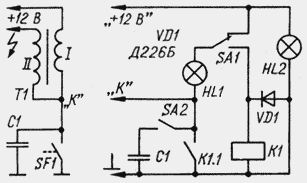The article describes the probe is intended for Troubleshooting the electrical equipment of the car on the road. In its simplicity the device provides a fairly large number of test functions.
Many motorists when looking for faults in electrical appliances his car still use a test lamp. To determine the simple reasons of failures of such a "device" is quite enough. But sometimes, especially in the road, it is important not only to verify the presence of voltage on one or another node, a questionable, but it works. Perhaps, in most of this relates to the nodes responsible for sparking where the high-voltage discharge louder than the illumination of the warning lamp.
Described below is a simple probe makes it easy to solve many problems arising the repair on the road. In addition to traditional warning lights HL2 (see diagram), it contains simulator breaker relay K1, which allows you to check the system sparking in the operating mode.

Diagram of the probe is shown in the initial position of all contact groups. Left on the figure shows a fragment of the schema node sparking car showing connection points of the probe.
Connect the probe in the off position of the ignition key of the vehicle. After the ignition should flash lamp HL2. In the absence of its glow check the connections for the terminals of the probe, and if necessary and the whole chain up to the plus output of the ignition coil T1.
If the lamp HL2 shines, and HL1 - no, it most likely means that the contacts circuit breakers are open (or short circuit in the wire from breaker to a common point "To" ignition coil - it needs to recover). Because it does not Shine lamp HL1, you can be sure that the capacitor C1 breaker SF1 on the body "not broken". It remains to check for breakage.
To do this, from the cover of PrivateAssemblies yank Central high voltage wire and strengthen its on the car so as to form a gap 10...15 mm between the end of the wire and the housing. Transfer switch SA1 probe in the bottom in the diagram position, wherein the relay K1 switches to buzzer mode and between the end of the ignition wire and the housing can be seen (and hear) spark discharges.
If it doesn't spark and they appear only when you reduce the gap to 5 mm, should to assume that either the capacitor C1 is torn off, or there is no contact between its output to the output "K" of the ignition coil. To verify this, closing the contacts of the switch SA2 probe, which is connected to the circuit of the capacitor C1 the same capacitance as the capacitor C1 of the circuit breaker. The emergence of full-fledged sparks a malfunction of the capacitor breaker.
Ensuring the health of the ignition coil and condenser breaker, set the switches SA1 and SA2 to its original position. Remove the lid dispenser, screwdriver and close the breaker contacts. With proper details breaker and connecting circuits shall be switched on the lamp HL1.
Recall that the above procedure corresponds check open as contacts SF1 breaker. In the case when the breaker contacts will be closed after ignition will turn on both lamps of the probe. Enough between the contacts is to put a thin dielectric plate, at least a piece of dry paper, and you can carry out the test as described above.
Attention! Don't forget after checking the ignition system to remove from the gap the insulation lining.
If the breaker contacts are closed, and the lamp HL1 does not illuminate, this means that they need cleaning.
The probe is mounted in a plastic box the size of 90x60x40 mm (estimated). At the end of the three flexible findings establish the crocodile clip with stiff springs. Pin length is 150 mm.
Relay - any automobile 12 In (see article V. Bannikov "Small automotive electromagnetic relay" in "Radio", 1994, No. 9, p. 42 No. 10, p. 41). Capacitor - motor or any other capacity of 0.22 UF voltage 600 V. Lamp - motor power does not exceed 4 watts.
Switches - any switches or PD-1. Diode VD1 - any of a series or D226 CD.
The probe can to help out in the road when failure of the capacitor circuit simply connect the probe to the two conductors to the point "K" and the body and to close the contacts SA2 (one of the lamps is better to take out from the socket). If translate relay K1 in buzzer mode, the ignition system will be multi-strike, to facilitate starting the engine in cold weather.
Author: A. Brugger, Barnaul






